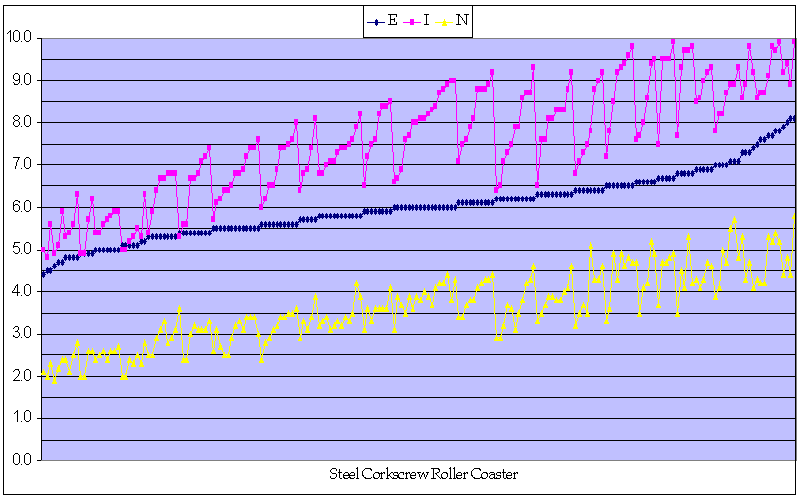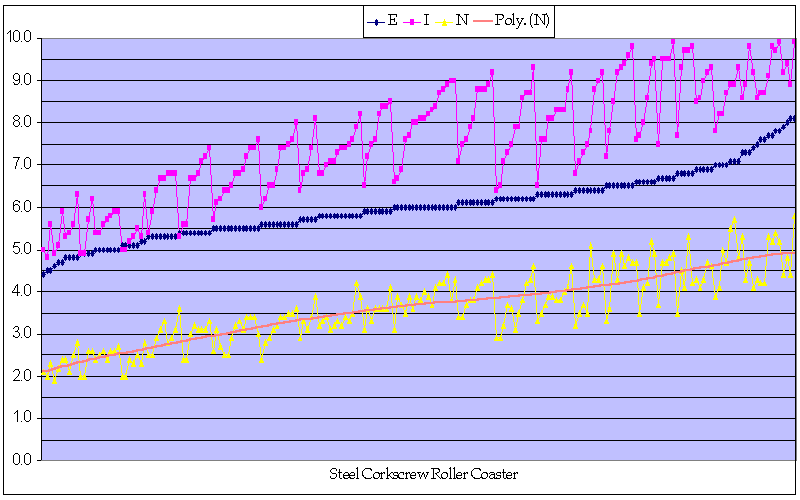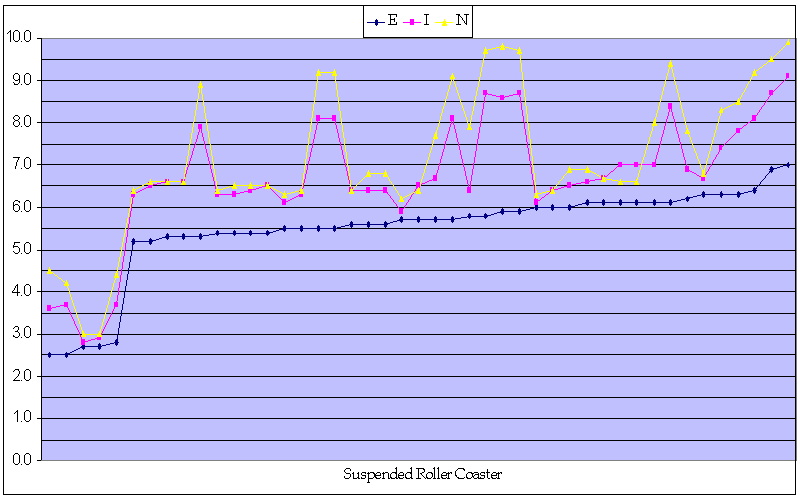Unlike the "fixed" rides; rides you construct yourself will have different base Excitement, Intensity, and Nausea specifications depending on the track design, vehicle selection, and operating mode. However one still wants to know what the typical ride specifications are, in order to better choose a ride to meet a specific E-I-N goal (i.e., if your goal is to have an Intensity of "High", it would be futile to work with rides that can only produce an Intensity of "Low").
To this end, saved tracks from the game were supplemented with saved tracks found on the Internet to form charts from which you can make E-I-N estimates. I assumed that Chris Sawyers rides and the rides published by persons on the Internet were examples of thoughtful creation, with attempts made to produce decent E-I-N specifications, and therefore good candidates for determining 'trendlines'. Poorly designed rides could easily have Intensity and Nausea specifications considerably greater than shown on these graphs. Note how I have more examples of some rides than others, which I believe is an artifact that can be attributed to ride popularity amongst gamers.
Note that the ratings for 'saved' tracks only extend 1 decimal place (the second decimal place is ignored), and the Excitement rating is a true base rating uninfluenced by scenery/interaction modifiers. Here is an example of a Steel Corkscrew Roller Coaster chart:

I chose to sort the data in the charts first by Excitement, then by Intensity, an finally by Nausea. When examining the graphs do not assume that, for example, a 5.0 Excitement will always equate to a 5.4 Intensity and a 2.4 Nausea. Although Intensity and Nausea often tend to follow each other (and the two in turn also tend to follow Excitement) the specifications are not directly coupled and will vary.
What you should try to derive from these graphs are "trends". Below is the same Steel Corkscrew Roller Coaster chart with a 6th order polynomial trendline superimposed over the Nausea rating:

Note the 'trend' of how base Excitement for a Steel Corkscrew Roller Coaster will typically (based on a sampling of 200 rides) fall between about 5.0 and 6.5. Note also how base Excitement can be made to fall to about 4.5 or increase to about 7.0. Note the 'trend' (clearly seen with the aid of the orange trendline) that an increase in Nausea level on the Steel Corkscrew Roller Coaster tends to closely follow an increase in base Excitement level. Note also the 'trend' that the "range" of Nausea level 'deviation' is lesser at the lower base Excitement levels (possibly due to the influence of selected track elements, as seems to be indicated by the lower Intensity levels). Other trends can also be seen.
From looking at the trends indicated in the chart, one could safely conclude that a typical Steel Corkscrew Roller Coaster would have an Excitement level of high and a Nausea level of medium. This is different from, for example, a typical Suspended Roller Coaster, where the swinging of the vehicles always seems to produce a Nausea level that will be greater than the rides Excitement level:

The charts which have few data points are harder for the gamer to derive accurate clues as to the rides typical E-I-N specifications. I am therefore providing all the ![]() E-I-N spreadsheets from which I derived all the charts. I suggest you populate the lacking spreadsheets with additional "quality" tracks you may have built/encountered. I urge that you limit the number of tracks to 200, and that you exclude tracks that contain an E, I, or N number in excess of 10.00. Don't forget that you can also sort the charts E-I-N specifications in a different order.
E-I-N spreadsheets from which I derived all the charts. I suggest you populate the lacking spreadsheets with additional "quality" tracks you may have built/encountered. I urge that you limit the number of tracks to 200, and that you exclude tracks that contain an E, I, or N number in excess of 10.00. Don't forget that you can also sort the charts E-I-N specifications in a different order.
Remember that all ride specifications in these spreadsheets are for isolated rides on undecorated flat land. Any ride can usually have its Excitement specification improved above these base numbers. Typical techniques are to surround the ride with scenery and themeing, add multiple tunnels, cross the ride with other rides and footpaths, and parallel ride tracks with same (including racing) or opposite direction moving traffic.